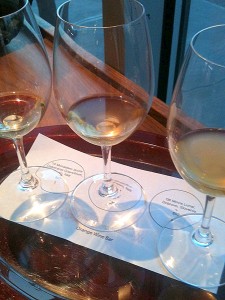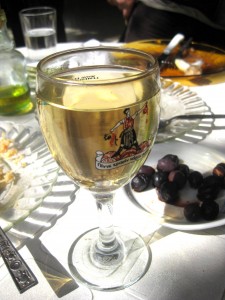 CENTRAL BOTTLE WAS POURING three so-called orange wines at its most recent Thursday Night Wine Bar event. We’ve written twice before on a category (I’ll cite those posts momentarily), that remains a controversial one. Why so? Because these wines are exactly the opposite of what the Robert Mondavi-UC Davis Axis of Normal mandates for white wines: that they be pale-hued, flawlessly limpid, and above all, fruity.
CENTRAL BOTTLE WAS POURING three so-called orange wines at its most recent Thursday Night Wine Bar event. We’ve written twice before on a category (I’ll cite those posts momentarily), that remains a controversial one. Why so? Because these wines are exactly the opposite of what the Robert Mondavi-UC Davis Axis of Normal mandates for white wines: that they be pale-hued, flawlessly limpid, and above all, fruity.
As you can see in the photo at left, the colors represented in the flight we sampled veer from straw to something like apricot juice and are more or less hazy in appearance. In both aroma and palate they back away from, rather than beat a path to, fruit expression.
Their deviant character is primarily the result of the intentional application of two cellar techniques: skin-contact during fermentation and exposure to oxygen during maturation. Each is taboo in mainstream commercial white winemaking, where juice is rapidly run off from skins to ferment apart from their influence, and where exposure to O2 is rigorously limited if not altogether denied.
These wines are exactly the opposite of what the Robert Mondavi-UC Davis Axis of Normal mandates for white wines.
This kind of control over the process only became possible with the advent of stainless steel, temperature-controlled tanks and the fixtures that allow wine to be moved around in an anaerobic (oxygen-free) environment.
 Thus, the appearance of orange wines (or “rusty whites” as Kenmore Square’s Island Creek Oyster bar styles them) represents something like time-travel in the sense that it gives us a taste of what fresh white wine must once have universally been: rather highly-colored, lightly-grippy, perhaps slightly fizzy — more or less like the homemade wine I drank in the mountain villages of Cyprus several years ago (right).
Thus, the appearance of orange wines (or “rusty whites” as Kenmore Square’s Island Creek Oyster bar styles them) represents something like time-travel in the sense that it gives us a taste of what fresh white wine must once have universally been: rather highly-colored, lightly-grippy, perhaps slightly fizzy — more or less like the homemade wine I drank in the mountain villages of Cyprus several years ago (right).
The unusual hues are attention getters, but the real story here is a spectrum of interesting fermentation and soil flavors that step into the foreground as primary fruit flavors and aromas recede. The intensity of effect seems to vary in direct proportion to the length of time the wine was left on its gross lees. Among the wines we tasted Thursday was a recurrent brown apple, dried apple, russet apple rind note — a common feature someone should take a stab at explaining. Some have noted similarities with cider – others with Belgian-style sour beers.
My sense is that for many wine drinkers, a first experience with these wines will be rather startling – something akin to tasting your first cup of black coffee and realizing that without milk and sugar it’s a very different thing indeed.
For more on orange wines and some useful observations about its affinities with sherry and other traditional wines, take a peek at Island’s Creek Oyster Bar’s Rusty Whites, and Well, we smelled it – and we liked it, as well as Sam Gugino’s Wine Spectator profile of Prince of the House of Orange Ales Kristancic. Then scoot over to Pameladevi Govinda’s impeccably-reported overview of the category, here, at Imbibe.
My notes from Thursday tasting appear below. All are available at Central Bottle Wine + Provisions in Cambridge.
2010 Monastero Suore Cistercensi “Coenobium” Lazio (Italy). Trebbiano, malvasia, verdicchio, grechetto blend. Just under two weeks of maceration. Limpid, pale bronze hue; modest aromas of brown apple flesh and concentrated russet apple rind; soil aspects dominant. Mouth shows pleasing acid structure with a lightly crisp, firm edge; texture softish overall; moderate persistence; some nuttiness emerges late. $27
2010 Denavolo “Dinovolino,” IGT Emilia (Italy). 25% malvasia di aromatica candia, 25% ortugo, 25% marsanne, 25% “unknown varieties from a 28 year-old vineyard.” Medium amber hue with some slight haze; aromas rather yeasty, fruit elements quite subdued but aspects of dried apple apparent; mouth shows surprisingly lively acidity; a slight barnyard note on the finish; texture is low and the feel distinctly dry. $30
2008 Movia “Lunar” Goriška Brda (Slovenia). 100% ribolla gialla. Hue is apricot juice with some significant turbidity; aroma profile rather low and indistinct; mouth has some depth and appealing nutty aspects. An intriguing sip for the adventurous palate. $52
Reach me at stephenmeuse@icloud.com
Follow @stephen_meuse